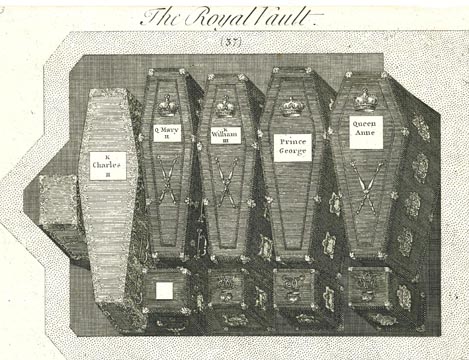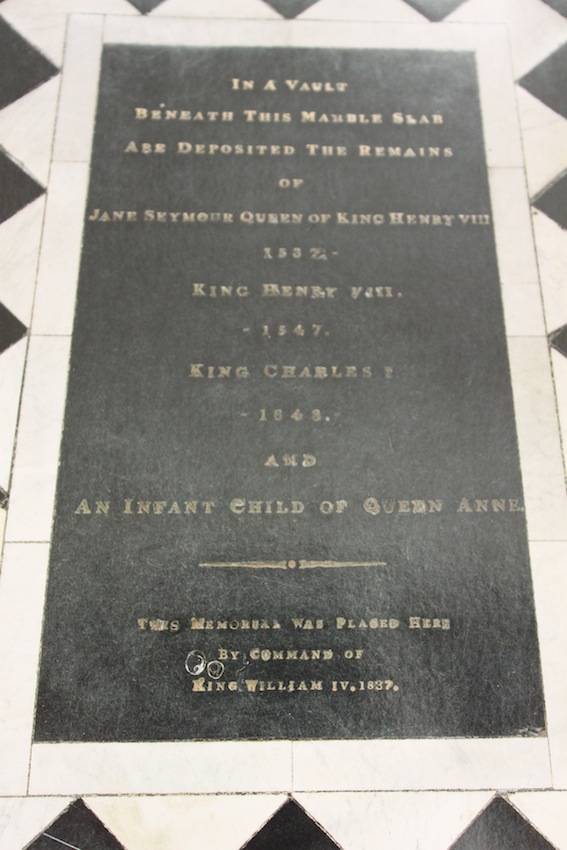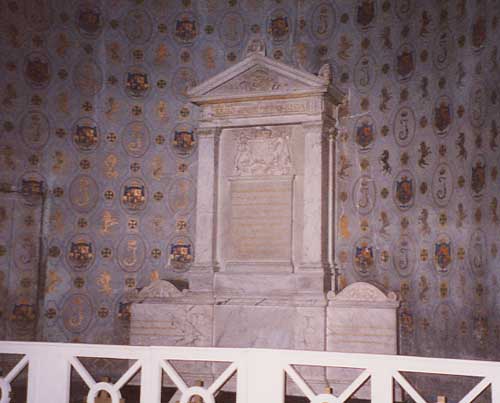by An Ard Rí and Susan Flantzer © Unofficial Royalty 2012
The Stuarts reigned in England, Scotland, and Ireland from 1603-1714. The House of Stuart had been the reigning house in Scotland since 1371. In 1603, King James VI of Scotland, the only child of Mary, Queen of Scots, succeeded the last Tudor monarch of England and Ireland, Queen Elizabeth I, who died without issue. In 1707, during the reign of Queen Anne, Scotland and England were united into a single kingdom called Great Britain. Most of the Stuart monarchs and consorts were buried in Westminster Abbey. However, none of them have a memorial or tomb there. They were buried in the vaults beneath the Henry VII Chapel at Westminster Abbey.
- Unofficial Royalty: Westminster Abbey
- Unofficial Royalty: Westminster Abbey: Royal Burials
- Official Website: Westminster Abbey
The Stuart Monarchs were:
- James I: reigned 24 March 1603 – 27 March 1625
- Charles I: reigned 27 March 1625 – 30 January 1649
- Charles II: reigned 29 May 1660 – 6 February 1685
- James II: reigned 6 February 1685 – 23 December 1688
- William III and Mary II: reigned jointly 13 February 1689 – until Mary’s death on 28 December 1694, William then reigned alone until his death on 8 March 1702
- Anne: reigned 8 March 1702 – 1 August 1714
Burial articles for all the British royal houses can be found at Unofficial Royalty: British Royal Burial Sites
An excellent resource: The Royal Tombs of Great Britain by Aidan Dobson, published in 2004
Unless otherwise noted, all pictures, portraits, and photos are from Wikipedia.
********************
James VI, King of Scots and James I, King of England (reigned Scotland 24 July 1567 – 27 March 1625, reigned England 24 March 1603 – 27 March 1625)

James was the only child of Mary, Queen of Scots and Henry Stuart, Lord Darnley. Following his mother’s abdication in 1567, one-year-old James became King of Scots. In 1589, James married Anne of Denmark. James became King of England and Ireland upon the death of Queen Elizabeth I in 1603. During James’ reign, the Golden Age of Elizabethan literature and drama continued, the Gunpowder Plot when Catholic Guy Fawkes conspired with others to blow up Parliament was averted, English colonization started in North America with the founding of Jamestown, Virginia, and the King James Version of the Bible was completed.
James’ health began to suffer from arthritis, gout, and kidney stones when he was about 50 years old. During the last year of his life, he was rarely well enough to be able to visit London. It is possible that he had porphyria, a hereditary disease that apparently afflicted his descendant King George III. In March of 1625, James became ill with a recurring fever and then suffered a stroke. He died on March 27, 1625, aged 58, at Theobalds House in Hertfordshire, England, one of his favorite country homes. His remains were then buried at Westminster Abbey in the vault of Henry VII and Elizabeth of York, his great-great-grandparents. Plans were drawn up for a monument in the classic style but the monument was never built. Only an inscription on the floor of the chapel marks his grave.
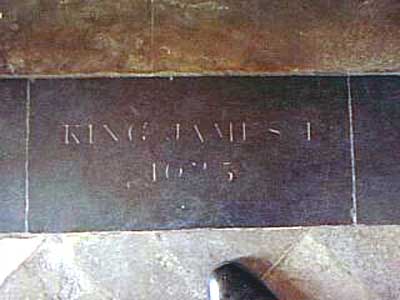
Inscription on the floor of the Henry VII Chapel at Westminster Abbey marking the nearby grave of James I; Photo Credit – findagrave.com
Anne of Denmark, Queen of Scots, Queen of England

Anne was the daughter of King Frederik II of Denmark and Sophie of Mecklenburg-Güstrow. She married James VI of Scotland in 1589. James and Anne had seven children and at least three miscarriages but only three of their children survived childhood. In 1603, James succeeded Queen Elizabeth I of England as King James I of England.
In 1612, 18-year-old Henry, Prince of Wales died from typhoid fever, which was a great tragedy for Anne and the entire nation. Anne could not bear to have Henry’s death mentioned and people were advised not to give her condolences. After her son’s death, Anne’s health began to deteriorate and she withdrew from social activities.
By 1617, Anne’s condition became debilitating. James visited Anne only three times during her last years but her surviving son Charles was often with her and was at her bedside when Anne died at the age of 44 from dropsy (edema) at Hampton Court Palace on March 2, 1619. Anne was buried at Westminster Abbey in a vault beneath the monument to the Dukes of Buckingham in the Henry VII Chapel. Her grave is marked by the inscription on the floor: “ANNE OF DENMARK QUEEN OF KING JAMES 1st 1619.”
********************
Charles I, King of England, King of Scots (reigned 27 March 1625 – 30 January 1649)

- Unofficial Royalty: King Charles I of England
- Unofficial Royalty: Execution of Charles I, King of England
King Charles I was one of the three children of King James I to survive childhood. He was not expected to be king as he had an older brother, Henry, Prince of Wales. Sadly, 18-year-old Henry died in 1612 from typhoid and Charles became the heir to the throne. In 1625, he married the Catholic Henrietta Maria of France. Charles’ conflicts with Parliament led to the English Civil War and ultimately to Charles’ death.
On January 20, 1649, Charles was tried for treason and other high crimes, was found guilty by 68 votes to 67, a majority of only one, and was sentenced to death. On January 30, 1649, Charles walked from St. James’ Palace to the Palace of Whitehall where a scaffold had been built outside the Banqueting House. It was a cold day, and Charles wore two shirts because he might shiver from the cold and he did not want it thought that he trembled from fear. From the first floor of the Banqueting House, Charles stepped onto the scaffold from a window, and several minutes later was beheaded.
No state funeral or public mourning was allowed and Charles was not permitted to be buried in Westminster Abbey. On February 7, 1649, Charles’ remains were taken to Windsor Castle where he was buried at St. George’s Chapel in the choir aisle in the vault where Henry VIII and his third wife Jane Seymour were buried. England was a republic (Commonwealth of England) for 11 years until the monarchy was restored and Charles I’s eldest son Charles II became king in 1660.
- Unofficial Royalty: St. George’s Chapel in Windsor, England
- Unofficial Royalty: St. George’s Chapel, Windsor: Royal Burials

Coffins of King Henry VIII (center, damaged), Queen Jane (right), King Charles I with a child of Queen Anne (left), vault under the choir, St George’s Chapel, Windsor Castle, marked by a stone slab in the floor; Credit – Wikipedia
Henrietta Maria of France, Queen of England, Queen of Scots

Henrietta Maria was the daughter of King Henri IV of France and his second wife Marie de’ Medici. In 1625, Henrietta Maria married King Charles I and they had nine children including King Charles II, King James II and Mary, Princess Royal who married Willem II, Prince of Orange, and had one child, Willem III, Prince of Orange, later King William III of England. During the English Civil War, Henrietta Maria returned to France but in 1660, when the English monarchy was restored and her son King Charles II took the throne, Henrietta Maria returned to England, where she was known as the Queen Mother. However, she found life there disagreeable and returned to France.
Henrietta Maria lived at the Château de Colombes near Paris and it was there that Henrietta Maria died on September 10, 1669, at the age of 59 from an overdose of opiates taken for pain on the advice of the doctor of her nephew King Louis XIV. Henrietta Maria was buried beside her father, King Henri IV of France, at the Basilica of Saint-Denis near Paris. Her heart was buried at the Visitation Convent Chapel at Chaillot, France, which she had founded in 1651. Her remains and the other royal remains at the Basilica of St. Denis were desecrated on October 16, 1793, when a mob pillaged the Bourbon crypt and threw the remains into mass graves. The convent building where her heart had been buried was destroyed during the French Revolution. In 1817, the mass graves were opened, the remains were collected, and then reburied in the crypt of the Basilica of Saint-Denis. Plaques next to the gated entrance of the burial site list the remains of those buried there.
- Unofficial Royalty: Basilica of Saint-Denis in St. Denis, France
- Unofficial Royalty: French Royal Burial Sites – House of Bourbon, House of Bonaparte, House of Orléans

Gated entrance to the reburial site of the French royals at the Basilica of Saint-Denis; Photo Credit – Susan Flantzer
********************
Charles II, King of England, King of Scots

King Charles II was the eldest surviving son of King Charles I and Henrietta Maria of France. Following the execution of his father in 1649, Royalists proclaimed him King, however, the monarchy was not restored until 1660. In 1662 he married the Catholic Portuguese Infanta Catherine of Braganza, daughter of King João IV of Portugal. Despite fathering many illegitimate children with his many mistresses, Charles had no children with Catherine.
On February 2, 1685, King Charles II suffered an apparent stroke and died four days later at the age of 54 at Whitehall Palace. Modern analysis of his symptoms seem to indicate he may have died from uremia, a symptom of kidney failure.
His remains were buried at Westminster Abbey in a vault under the monument to George Monck, Duke of Albemarle in the Henry VII Chapel. William III, Mary II, Anne, and her husband George of Denmark were also buried in this vault. An inscription on the floor marks the grave. A life-size wax effigy, 6 feet 2 inches tall, stood by Charles II’s grave for many years. The effigy is now in the Abbey Museum and is quite life-like.
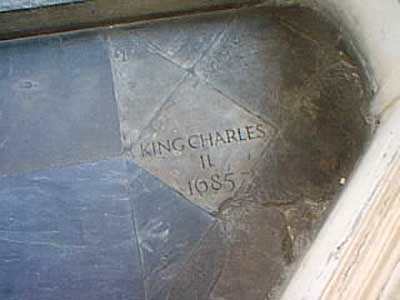
Inscription in the floor of Westminster Abbey marking the grave of Charles II; Photo Credit – findagrave.com
Catherine of Braganza, Queen of England, Queen of Scots

Catherine of Braganza was the daughter of King João IV of Portugal. In April 1662, she married King Charles II. Despite fathering at least 16 illegitimate children with his mistresses, Charles II had no children with Catherine. It is thought that Catherine did have at least three miscarriages. Despite having many mistresses, Charles insisted that Catherine be treated with respect, and sided with her over his mistresses when he felt she was not receiving the respect she was due.
Catherine of Braganza continued to live in England after the death of her husband. However, after her brother-in-law King James II was overthrown in 1688 by the Glorious Revolution and his daughter and her first cousin husband took the throne as King William III and Queen Mary II, Catherine found that her position with the new monarchs deteriorated and she decided to return to Portugal in 1693.
Catherine died at her Palace of Bemposta in Lisbon, Portugal on December 31, 1705, at the age of 67. She was originally buried at the Jerónimos Monastery in Lisbon, Portugal. On September 29, 1855, Catherine’s remains along with the remains of other family members were re-interred at the Royal Pantheon of the House of Braganza in the Monastery of São Vicente de Fora in Lisbon, Portugal.
- Unofficial Royalty: Monastery of São Vicente de Fora in Lisbon, Portugal
- Unofficial Royalty: Portuguese Royal Burial Sites – House of Braganza
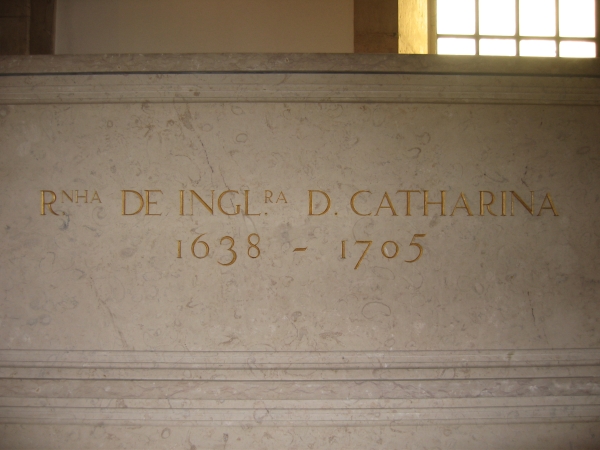
Tomb of Catherine of Braganza at the Monastery of São Vicente de Fora; Photo Credit – findagrave.com
********************
James II, King of England, James VII, King of Scots (reigned 6 February 1685 – 11 December 1688)

James was the second surviving son of King Charles I and Henrietta Maria of France. His first marriage in 1660 was to Lady Anne Hyde, who died before he became king. James and Anne were the parents of Queen Mary II and Queen Anne, James secretly converted to Catholicism in 1668 or 1669 and married the Catholic Mary of Modena in 1673. He became king upon the death of his (legitimately) childless brother Charles II.
As King, James II was set on a course of restoring Catholicism to England. England might very well have tolerated King James II knowing that his heirs were the Protestant daughters of his first wife Anne Hyde, Mary and Anne. However, on June 10, 1688, Queen Mary Beatrice, who had no surviving children, gave birth to a Catholic son, James Francis Edward. James II was overthrown in 1688 in the Glorious Revolution. and he went into exile in France.
James died from a stroke on September 16, 1701, at the Palace of St. Germain-en-Laye near Paris, where a court in exile had been established. His remains were buried at the Chapel of Saint Edmund in the Church of the English Benedictines in the Rue St. Jacques in Paris and his viscera were buried at the Parish Church of Saint-Germain-en-Laye. In October of 1793, the Chapel of Saint Edmund and all the English Benedictine buildings were destroyed by a mob along with the remains of King James II. His viscera were rediscovered and reburied in 1824 at the Parish Church of Saint-Germain-en-Laye. In 1855, Queen Victoria paid for a memorial to James at the Parish Church of Saint-Germain-en-Laye.
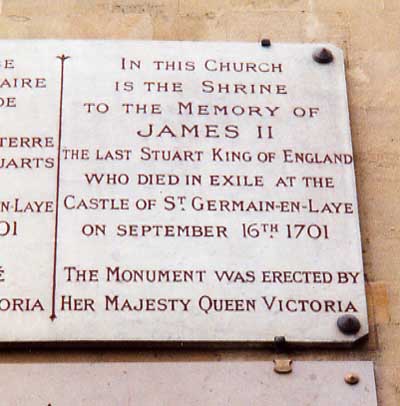
Plaque on the Parish Church of Saint-Germain-en-Laye; Photo Credit – findagrave.com Photo Credit – findagrave.com
Lady Anne Hyde, Duchess of York
Lady Anne Hyde was the daughter of Edward Hyde (later created 1st Earl of Clarendon) who was Chancellor of the Exchequer during the later reign of King Charles I. After the execution of King Charles I, Hyde became an adviser to the king in exile, Charles II, and soon became his chief adviser, and then was appointed Hyde Lord Chancellor in 1658. Given the situation, it was natural that Anne should come into contact with members of the exiled English royal family including King Charles I’s second surviving son, James, Duke of York. On November 24, 1659, Anne and James made a secret marriage in front of witnesses. When the monarchy was restored in 1660, James and Anne returned to England. They had eight children, but only two survived childhood and both were Queens Regnant: Mary II and Anne.
In 1667, Anne gave birth to her last son Edgar (died in 1671) and admitted that she never again felt well after his birth. By 1670, Anne was very ill with breast cancer, and once again pregnant. She gave birth to her last child Catherine on February 9, 1671 (died in December 1671) while in the advanced stages of breast cancer. On March 30, 1671, after returning home to St. James’ Palace from a dinner, Anne collapsed. Anne, Duchess of York died on March 31, 1671, at the age 34 and was buried at Westminster Abbey in the vault of Mary, Queen of Scots in the Henry VII Chapel.
Maria Beatrice of Modena, Queen of England, Queen of Scots

Maria Beatrice of Modena, daughter of Alfonso IV, Duke of Modena, and his wife, Laura Martinozzi, was the Italian-born second wife of James II. Maria Beatrice followed James II to his exile in France where James’ first cousin, King Louis XIV, gave them the use of Château de Saint-Germain-en-Laye near Paris.
On May 7, 1718, Maria Beatrice died of breast cancer at the age of 59. She was buried at the Convent of the Visitations in Chaillot and her viscera were buried at the Parish Church of Saint-Germain-en-Laye. Her remains were lost in 1793 when the convent was looted and destroyed during the French Revolution. However, her viscera were found and were reburied at the Chapel of the College of the Scots in Paris.
********************
Mary II, Queen of England, Queen of Scots (reigned 13 February 1689 – 28 December 1694)

Queen Mary II was the elder surviving daughter of King James II and Anne Hyde. Mary married her first cousin, Willem III, Prince of Orange, in November 1677 but their marriage was childless. The couple jointly came to the throne as King William III and Queen Mary II following the Glorious Revolution which deposed Mary’s father. William was often on military campaigns in Europe and left Mary to reign. She was not keen on assuming such power but did so with the advice of a nine-member Cabinet Council.
In early December 1694, Mary became ill with smallpox which had killed both William’s father, Willem II, Prince of Orange before William’s birth and his mother, Mary Princess Royal, when William was ten-years-old. In the early morning of December 28, 1694, Mary peacefully died at Kensington Palace. She was just 32 years old. William was terribly grief-stricken, collapsed at Mary’s bedside, and had to be carried, nearly insensible, from the room. For a few days, it was feared that William too would die.
Mary lay in state in the Banqueting Hall of Whitehall Palace. Despite the cold weather, large crowds lined up to file past their Queen and pay their respects. On March 5, 1695, in a heavy snowstorm, the funeral procession traveled the short distance from Whitehall Palace to Westminster Abbey. The King was not present, according to custom, but all members of both Houses of Parliament, all wearing black, attended the funeral. The noted English composer Henry Purcell specially composed Music for the Funeral of Queen Mary.
YouTube: Purcell – Music for the Funeral of Queen Mary
Queen Mary II was buried in a vault under the monument to George Monck, Duke of Albemarle in the Henry VII Chapel of Westminster Abbey. Charles II, Mary’s husband William III, Mary’s sister Anne and her husband George of Denmark were also buried in this vault. A joint monument for William III and Mary II was designed but never constructed. An inscription on the floor marks her grave. William reigned alone until his death in 1702 when he was succeeded by Mary’s sister Anne.
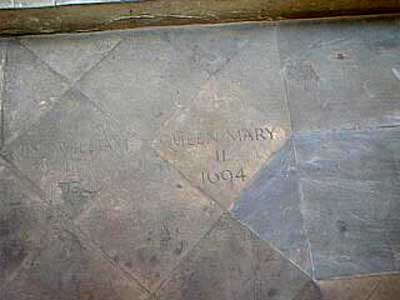
Inscription on the floor of the Henry VII Chapel at Westminster Abbey marking the grave of Mary II; Photo Credit – findagrave.com
William III, King of England and William II, King of Scots (reigned 13 February 1689 – 8 March 1702)

Born Willem III, Prince of Orange, the son of Willem II, Prince of Orange, who died of smallpox eight days before his son’s birth, and Charles I’s daughter Mary, Princess Royal, who died of smallpox when her son was ten-years-old, he married his first cousin, the future Mary II, in 1677. Following the Glorious Revolution, King William III and Queen Mary II became joint sovereigns. After Mary’s death, he continued to reign as a sole sovereign.
On February 20, 1702, William went riding on his horse Sorrel at Hampton Court Palace. The horse stumbled on a molehill and fell. William tried to pull the horse up by the reins, but the horse’s movements caused William to fall on his right shoulder. His collarbone was broken and was set by a surgeon, but instead of resting, William insisted on returning to Kensington Palace that evening by coach. A week later, it was discovered that the fracture was not mending well and William’s right hand and arm were puffy and did not look right. His condition continued to worsen and by March 3, William had a fever and had difficulty breathing. King William III died at the age of 51, on March 8, 1702, at Kensington Palace. While Mary had been buried with pomp, William was buried at Westminster Abbey in a private, modest ceremony at midnight on April 12, 1702.
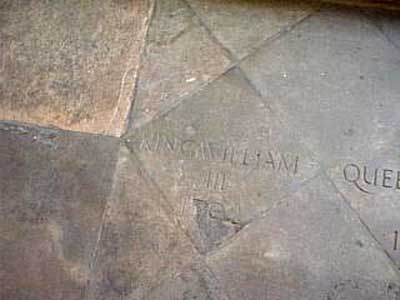
Inscription on the floor of the Henry VII Chapel at Westminster Abbey marking the grave of William III; Photo Credit – findagrave.com
********************
Anne, Queen of Great Britain (reigned 8 March 1702 -1 August 1714)

Anne was the younger sister of Mary II and following the death of William III, she succeeded to the throne. During her reign, an Act of Parliament united England and Scotland into one realm called Great Britain. Anne had 17 or 18 pregnancies between 1684 and 1700. Only one child survived, Prince William, Duke of Gloucester, who died when he was eleven. The failure of the Protestant Stuarts to produce heirs meant the end of the Protestant Stuart dynasty because all the legitimate descendants of King Charles I were either childless or Roman Catholic.
The Act of Settlement 1701 secured the Protestant succession to the throne after Queen Anne. Parliament’s choice was limited to the Protestant descendants of Elizabeth of Bohemia, the only other child of King James I not to have died in childhood. The senior Protestant descendant was Elizabeth of Bohemia’s youngest daughter Sophia, Electress of Hanover. The Act of Settlement put Sophia of Hanover and her Protestant heirs in the line of succession after Anne.
Queen Anne suffered a stroke on July 30, 1714, and she died at Kensington Palace on August 1, 1714, at the age of 49 after suffering another stroke. She was buried at Westminster Abbey in a vault under the monument to George Monck, Duke of Albemarle in the Henry VII Chapel. Charles II, William III, Anne’s sister Mary II, and Anne’s husband George of Denmark were also buried in this vault. Anne had become so obese that her coffin was much larger than the other coffins in the vault as can be seen in the drawing at the beginning of this article. Electress Sophia of Hanover, the heir to the throne according to the Act of Settlement, had died on June 8, 1714, just six weeks before the death of Queen Anne, and so Sophia’s son became King George I and started the Hanover dynasty.
Prince George of Denmark and Norway, Duke of Cumberland

Prince George was the son of King Frederik III of Denmark and Sophie Amalie of Brunswick-Lüneburg and consort of Queen Anne. They married in July 1683, George, however, remained a Lutheran. Prince George played no part in politics and had no real ambitions. His uncle by marriage, King Charles II, famously said of George, “I have tried him drunk, and I have tried him sober, and drunk or sober, there is nothing there.
In March and April 1706, George was seriously ill but seemed to recover. He spent much of the summer of 1708 at Windsor Castle with asthma that was so bad he was not expected to live. Prince George died on October 28, 1708, at Kensington Palace in London at the age of 55. Queen Anne grieved him deeply. She was desperate to remain with George’s body but reluctantly left after being persuaded by Sarah, Duchess of Marlborough. George was buried privately at midnight on November 13, 1708, at Westminster Abbey in a vault under the monument to George Monck, Duke of Albemarle in the Henry VII Chapel. Charles II, William III, Mary II, and George’s wife Anne were also buried in this vault.
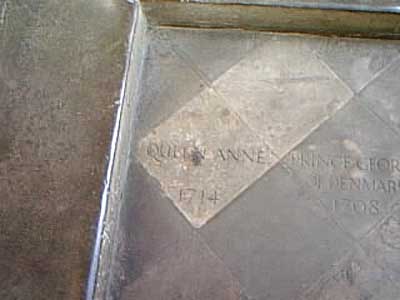
Inscription on the floor of the Henry VII Chapel at Westminster Abbey marking the graves of Queen Anne and Prince George; Photo Credit – findagrave.com
********************
This article is the intellectual property of Unofficial Royalty and is NOT TO BE COPIED, EDITED, OR POSTED IN ANY FORM ON ANOTHER WEBSITE under any circumstances. It is permissible to use a link that directs to Unofficial Royalty.

